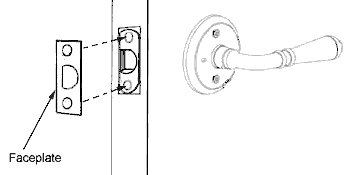
Thinking about your door’s latch faceplate is like examining the soles of your shoes. Just as the wear on your shoes reflects where you’ve walked, the wear on a latch faceplate indicates how frequently a door has been opened, how forcefully it’s been used, and even the environmental factors at play. Let’s dive into this seemingly simple topic and see how it can provide unique insights into everyday life.
What Are Door Latch Faceplates?
Door latch faceplates are the metal or plastic plates that cover the latch mechanism on your door. They serve several important functions. Primarily, they protect the door frame from damage caused by the latch and help hold the latch in place. Think of them as the unsung heroes of door hardware—they quietly go about their job without much fanfare.
These plates come in various materials, from brass to stainless steel, and can even differ in finishes. Some have a polished look, while others offer a more matte appearance. The type of latch faceplate you choose can affect not just the aesthetics of your door but also its durability and resistance to wear over time. If you’re curious about which type is best for your home, let’s look deeper.
Understanding Wear Patterns
Analyzing wear patterns on door latch faceplates can be quite revealing. When you look closely, you might notice scratches, discoloration, or even dents. These marks provide clues about the door’s usage and can help you understand its history.
For example, scratches may indicate frequent use, particularly if you have a door that swings open and closed multiple times a day. Discoloration could point to exposure to sunlight or moisture, possibly suggesting the door isn’t properly sealed. Dents might indicate a more forceful interaction—perhaps someone accidentally slammed the door or leaned against it.
Understanding these wear patterns can also help you identify potential issues. If you notice excessive wear on one side of the faceplate, it might indicate that the door is misaligned and needs adjustment. This proactive approach can save you from future headaches.
Common Materials and Their Durability
The material of your door latch faceplate affects how quickly it shows wear. Here are a few common options:
- Brass: Known for its classic look, brass is strong but can tarnish over time, leading to discoloration.
- Stainless Steel: This is a popular choice for its durability and resistance to corrosion. It usually shows wear slower than other materials.
- Plastic: While budget-friendly, plastic faceplates tend to wear down faster and may not hold up as well under heavy use.
When analyzing wear patterns, consider the material. For instance, brass might show more scratches than stainless steel, but with proper maintenance, it can retain its charm for years. If you’re weighing durability against aesthetics, knowing how these materials respond to wear helps you make informed decisions.
Identifying Common Wear Issues
As you analyze the wear on your door latch faceplate, you might come across some common issues:
1. Corrosion: This is common with metal faceplates exposed to moisture. Look for rust spots or flaky surfaces, which can compromise the functionality of the latch.
2. Cracking: Especially in plastic faceplates, cracking can occur due to temperature changes or impacts. Cracks reduce both aesthetics and security.
3. Alignment Problems: Misalignment can cause uneven wear, which might lead to functional issues. If a latch faceplate is worn more on one side, it’s a sign the door may need adjustment.
Identifying these issues early keeps your doors in good condition, ensuring they work smoothly for years to come.
The Importance of Regular Maintenance
Regular maintenance of your door latch and its faceplate can significantly extend their lifespan. Here are a few easy steps you can take:
– Clean the Surface: Use a soft cloth to remove dust and grime. For metal faceplates, consider using a gentle cleaner to prevent tarnishing.
– Check for Damage: Regularly inspect the faceplate for any dents, scratches, or signs of wear. If you spot issues, addressing them early can save you trouble down the line.
– Lubricate the Mechanism: A little lubricant can go a long way in ensuring your latch operates smoothly. This will also help reduce wear on the faceplate itself.
Taking these simple actions not only helps maintain the faceplate but also bolsters the overall health of your door hardware. Trust me; a little attention can pay off in the long run.
When to Replace Your Door Latch Faceplate
You might be wondering when it’s the right time to replace a door latch faceplate. Here are some indicators to look for:
– Severe Damage: If your faceplate is cracked, rusted, or heavily scratched, it’s time for a replacement. Not only is this a matter of aesthetics, but damaged faceplates can compromise your door’s security.
– Frequent Operational Issues: If your door latch is sticking or not engaging properly, the faceplate might be worn down over time, impacting the latch’s functionality.
– Loss of Aesthetic Appeal: Sometimes, wear patterns might make a faceplate look dated or ugly. If you’re renovating or redecorating, consider swapping out the faceplate for a fresh look.
Replacing a faceplate is often straightforward and can have a significant impact on the overall appearance and functionality of your door.
In Conclusion
Analyzing the wear patterns on door latch faceplates offers a window into not just the usage of your doors but also the impact of environmental factors and maintenance practices. By paying attention to these little details, you can extend the life of your hardware and keep your home looking its best.
Whether you’re dealing with scratches, corrosion, or general wear and tear, understanding these signs can guide your maintenance efforts. So next time you walk through a door, take a moment to appreciate the story told by its latch faceplate. You never know what you might learn!